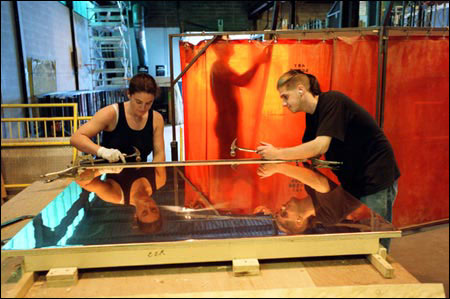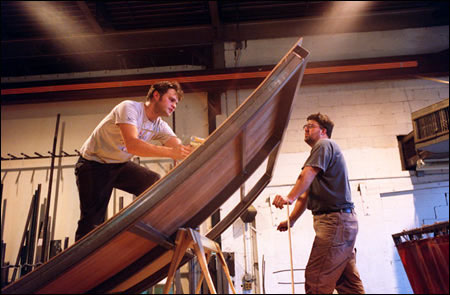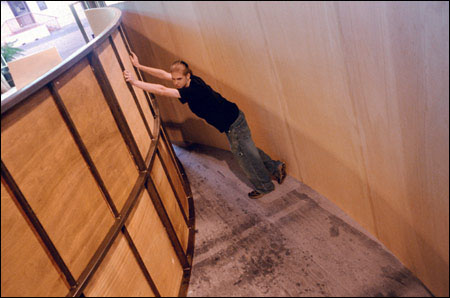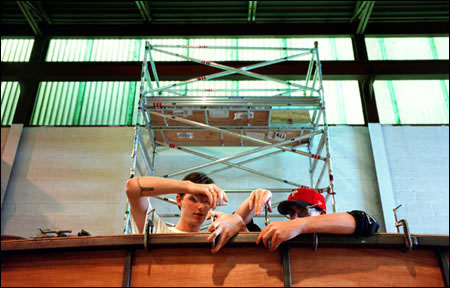Behind the scenes in scene construction:
A.R.T.’s innovative designers challenge builders’ ingenuity

Maybe you thought Chekhov’s “Uncle Vanya” was a play about bored, morose Russians whining interminably about their frustrating provincial existences, but here in the American Repertory Theatre (A.R.T.) scene shop it’s all about the ceiling.
This November, when it travels in sections from the North Cambridge warehouse where it is being built and then set up in the main theater of the Loeb Drama Center, the ceiling will jut out over the audience like the wing of a Boeing 737. It will dwarf the actors, emphasizing the sense of oppression and entrapment, or at least that is what director János Szász and set designer Riccardo Hernandez hope will happen.

Constructed of lauan sheeting over a steel and aluminum frame and textured with a coating of glue and clay, the ceiling will weigh approximately 7,000 pounds. Rigging it securely and safely in place is an engineering problem that the scene shop’s technical director Stephen Setterlun and his colleagues are now struggling with.
“The A.R.T. brings in directors and set designers and says, you do what you think the play needs,” Setterlun says. “Then they ask me, Is it possible?”
Setterlun prefers to say yes, if he can. If not, he’ll try to come up with a viable alternative.
A math major at the University of Wisconsin where he earned his bachelor’s degree, Setterlun was also attracted to art and theater. He was planning a career in architecture, but when the opportunity to study scenic design came along, he realized it offered the perfect opportunity to meld his artistic aspirations with his penchant for precision and practicability.

Now he presides over this huge barn of a place echoing with the sounds of power tools and rock music where visionary decor by some of the world’s most cutting-edge designers is given concrete form. In addition to the “Uncle Vanya” set, there are bits and pieces of a highly abstract set for “La Dispute” by 18th century French playwright Marivaux. Designed by Neil Patel, the set might be described as heavy metal, with floor and walls of gleaming copper and a maze of curved panels painted to look like rusted steel.
“A lot of the younger designers tend to be very material-specific,” says Setterlun. “They want actual bricks on stage, real dirt and dust, real copper. They’re not nuts. It does make a difference, but there are still a lot of people who have a hard time with this, because 20 or 30 years ago, it was all about illusion.”

Setterlun takes a practical approach. Copper laminate, for example, which some set technicians might prefer over actual copper sheeting, costs more than the real thing, so why use it? Real Corten steel, on the other hand, would be so heavy that stage hands couldn’t budge it – hence, the faux version.
But whether the material is real or a facsimile, the scene shop does go through a lot of it – wood, metal, cloth, paper, paint – not to mention more exotic substances like the one-and-a-half-inch-thick acrylic out of which Setterlun and his colleagues fashioned a transparent, back-lit floor for Shaw’s “The Doctor’s Dilemma.”
“I think all of us in the theater wonder, what is this all about? It does bother me that we spend more time creating sets than the play lasts. It’s like spending all day cooking a meal and then your guests eat it in 15 minutes. But then I tell myself, everything is fleeting. It’s there, and then, poof! it’s gone.”




